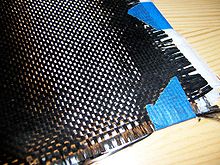Composite material
Composite materials are made from two or more basic material. They are not just placed together. They are merged together. This create a material with useful properties unlike the individual elements.

The composite material as a whole may behave differently from either of its parts. For example, reinforced concrete (made of concrete and steel) has resistance to pressure and to bending forces. Bullet-proof glass (made of glass and plastic) is far more resistant to impact than either glass or plastic on their own.
Concrete itself is a composite material. It is one of the oldest man-made composites, used more than any other man-made material in the world.[1]
Wood is a natural composite of cellulose fibres in a matrix of lignin.[2][3] The earliest man-made composite materials were straw and mud combined to form bricks for building construction. This ancient brick-making process was documented by Egyptian tomb paintings. It is still used today in some places.
Fibre-reinforced polymers are in wide use today, as is glass-reinforced plastic.

The Biblical book of Exodus tells of the Israelites that were oppressed by Pharaoh and forced to make "bricks without straw".[4]
Related pages
changeReferences
change- ↑ Lomberg, Bjorn 2001. The skeptical environmentalist: measuring the real state of the world. Cambridge University Press, p138. ISBN 978-0-521-80447-9
- ↑ Hubbe M.A. & Lucia L.A. 207. The love-hate relationship present in lignocellulose materials. Bioresources. 2, 534.[1]
- ↑ Hon, David and Shiraishi, Nobuo (eds) 2001. Wood and cellulose chemistry. 2nd ed, New York: Marcel Dekker.
- ↑ The old brick-making process can still be seen on Egyptian tomb paintings in the Metropolitan Museum of Art.[2] Archived 2007-10-25 at the Wayback Machine.
Other websites
change- Composite material key concepts Archived 2010-02-06 at the Wayback Machine
- Society of Manufacturing Engineers: Plastics, Composites & Coatings Community Archived 2007-11-02 at the Wayback Machine